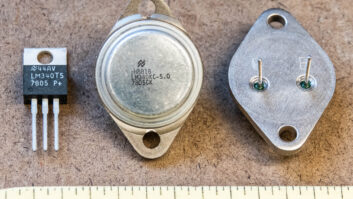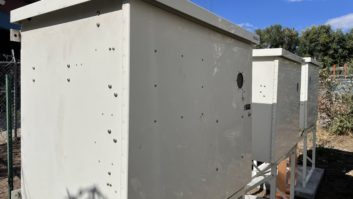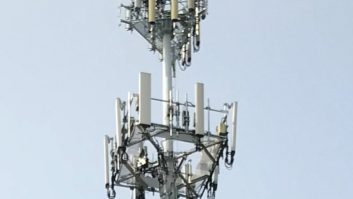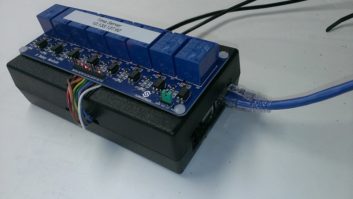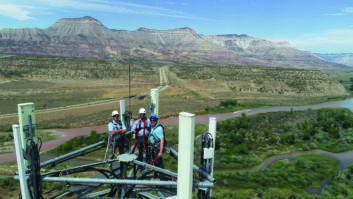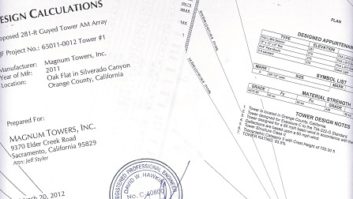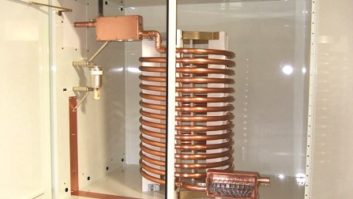Top loading, part 2 of 2
Dec 1, 2001 12:00 PM, By John Battison, P.E., technical editor, RF
Part One described the events leading to the development of top loading of broadcast AM antennas. This part continues with details of the types of top loading and discusses the use of the FCC’s Rules in planning a top-loaded antenna system.
Figure 1 shows one method of driving a top-hatted quarter-wave AM antenna. The top hat is insulated from the top of the tower and connected via a small network designed to provide the proper impedance match to the end of the coaxial cable, which is insulated from the tower. The current distribution for this construction is also shown dotted in Figure 1.
The top hat is not designed to raise the impedance but to raise the horizontal field intensity and reduce the high angle radiation that comes with a shorter tower.
The top hat performs as an elevated ground system, or as a counterpoise. Maximum current occurs at the top of the tower not at the overall height point. Current in the top hat flows radially and does not contribute to the total radiation from the antenna. The additional height of the top hat does not act as part of the radiator.
At the bottom of the tower, across the base insulator, there will be an infinite impedance because the tower and the outer coaxial conductor form a quarter-wave stub with a short circuit at its upper end. The transmission line is insulated from the tower and connected to it where the top hat is mounted. No current flows on the outer coaxial conductor.
I have rarely heard of this type of antenna system being used commercially. The high voltage at the base is probably a deterrent for broadcasters.Consulting engineer Tim Cut-forth, P.E., has done much work on elevated ground systems and other exotic antennas. This inverted antenna was included to illustrate the many uses of a quarter-wave stub in antenna work and as another method of top loading.
Loading inductances placed in the vertical radiator are a natural consideration. There are three possible locations for such additional lumped inductance: at the base, in the center and at the top. Most readers have either experimented as hams, or seen such devices on a ham’s automobiles. While these loading coils work well for the amateur, they do not fit easily into a large broadcast tower.
A base lumped inductance requires special mounting methods, either across the base insulator or inserted into the tower. The center coil requires an insulated break in the center. The top mount is easiest but still requires some engineering to do it satisfactorily. In all cases, the coil must be large and is subject to possible weather damage.
Only the top-mounted coil would give much improvement. Effective radiation requires high current through as much of the radiator as possible. In this case, the current would pass through all of the tower below the coil. Center loading provides the highest current in the lower portion of the tower, which would result in the least effective radiation.
Make a difference
For effective straight top loading use the top portions of the guy wires as the loading device. It is simple, inexpensive and usually very successful. If necessary, a folded unipole can be used in addition.
Figure 2 shows a typical top-loaded tower. Adding the length needed to make the overall length a quarter-wave seems to work well. The temptation to make the guy radiators too long can be strong. If the loading wires go down too far, they will shield the vertical radiator and reduce efficiency. A ring wire should go around the lower ends of the loading guys, joining them together. It is essential to ensure that all guy top ends are cleanly and securely connected to the top of the tower and that the ring wire is similarly well connected to the lower ends. Figure 3 shows a variation on top loading.
It has been my experience that the Commission will accept an application specifying a top-guy loaded antenna with dimensions that are reasonable and specifying a radiation figure that meets the applicable Rule.
The objective of top loading is to increase the antenna’s electrical length to as close as possible a minimum of 90�. How it is done depends on the engineer and the desired effect. A combination of top-guy loading and use of a folded unipole antenna may present the best choice. This combination should give greater ease of adjustment, a desirable base operating resistance, lower Q, a grounded tower and a broader bandwidth. Many stations prefer using folded unipole antennas to using only top-guy loading.
I feel that the folded unipole is a form of top loading because it produces the similar effect of increased operating resistance and usually improves bandwidth.
For many years, the FCC’s Rules had no formal provision in Form 301 for the use of top loading, and applications were accepted based on consulting engineer experience and engineering showing. Today’s Form 301 provides spaces for loading and sectional antenna data and simplifies the application.
Frequently, when issued, the CP contained provisions for proof of performance measurements to be conducted on non-directional stations after construction to show that the required efficiency was obtained. This requirement was not confined to rooftop stations, but also applied to stations built on terra firma whose antenna systems might not meet the Commission’s efficiency figures.
The Commission’s Rules in Section 73.160 provide a guide to calculations for the vertical radiation characteristics involving the use of top-loaded and sectionalized towers. However, these calculations are not necessary if the station is non-directional and a daytimer. This value is referred to as f(u) where u is the vertical angle of radiation. In a daytimer, unless it has to observe critical hour protection, only ground level radiation (horizontal) is used in the application.
Non-DA and daytime stations are not concerned with vertical plane radiation and use only the horizontal radiation at ground level f(0). However, f(u) enters into most directional antenna studies. Section (b)(2) of 73.160 provides the equation for calculating f(u) if any reader needs it.
When filing an application specifying any type of antenna, other than a standard vertical of sufficient height to meet the radiation Rules, the Commission will require sufficient engineering data to convince them that the proposed antenna will meet their standards.
E-mail John at[email protected].





